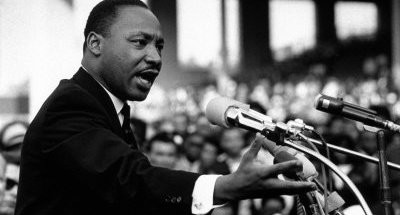
Change Can Start in a Cubicle
Some 50 years after Martin Luther King, Jr., described his dream of racial equality, Dr. King’s dream seems like a mirage: tantalizingly close at times but impossible to grasp.
As the recent national elections showed, there’s still a wide chasm between races: A Reuters/Ipsos poll found that Donald Trump won the U.S. presidency with less support from black and Hispanic voters than any president in at least 40 years. Foreshadowing these deep national divisions, an earlier Reuters/Ipsos poll found that 40 percent of white Americans don’t have non-white friends and 25 percent of non-white Americans have no friends outside of their racial demographic.
This sub rosa segregation spills over into the workplace. African-Americans are stunningly under-represented in the highest corridors of power. Only five blacks currently hold Fortune 500 chief executive positions. The most recent data from 2012 shows that they hold less than 10 percent of board seats at Fortune 100 companies and barely 7 percent of board seats at Fortune 500 companies.
It’s not from a lack of ambition. Research from the Center for Talent Innovation shows that 79 percent of college-educated, full-time employed African-Americans consider themselves ambitious, compared to 66 percent of Caucasians. Yet engrained bias continues to thwart their path upward. Some 73 percent of African-Americans feel that executive presence -- that aura that confers leadership potential -- at their company is defined as conforming to traditionally white male standards; 34 percent of African-American women and 41 percent of African-American men feel they need to compromise their authenticity to conform to EP standards at their company.
In today’s uneasy political climate, the workplace is one place -- maybe the only place -- that brings people of different colors and creeds together. Companies aren’t cloisters: Our opinions, biases, and prejudices slip through even the tightest security screens. Conversely, behavior that is winked at or condoned at the workplace seeps out into the parking lots and beyond.
Management scholar Muriel Maignan Wilkins noted in a Harvard Business Review article that “there is a connection” between the deaths of Eric Garner in New York, Michael Brown in Missouri, and Sandra Bland in Texas and company policies that unconsciously perpetuate racial bias. Calling for corporate leaders to take action, she wrote, “Corporate executives are in a prime position to lead the change needed in the workplace by addressing issues of unconscious bias.”
What can companies do? They can take actions on three levels.
Within their own walls: Companies can create programs that address the challenges that black professionals and other minorities face in the workplace, specifically by helping overlooked talent gain visibility, teaching the nuts and bolts and tactics of sponsorship, and providing protégés with the tools and capabilities they need for success. For instance, Chubb’s Multicultural Business Roundtable (BRT) seeks to increase Chubb’s ability to attract, retain and foster the career development of multicultural talent. It also serves as a catalyst for market facing initiatives that attract diverse business opportunities by leveraging Chubb’s multicultural talent and external relationships, and enhancing Chubb’s brand recognition among multicultural prospective employees, distribution partners, customers and business communities.
Within their communities: Taking a public stand against social injustices gives companies an opportunity to connect more strongly with their customers, employees and community. “Customers vote with their wallets and employees are choosing to work for companies that support their values,” says Deborah Small, a professor of marketing at the Wharton School at the University of Pennsylvania, quoted in a USA Today article.
Throughout the country: Through their behavior, companies can become ambassadors for advocacy not just locally but on the national level. In 2015, for example, Wal-Mart, e-Bay, Amazon, Target and Sears removed Confederate merchandise from stores and online sites, and Apple, Eli Lilly and Wal-Mart slammed Indiana and Arkansas for their “religious freedom” laws that could allow companies to deny service to gay people.
The workplace is a melting pot and a microcosm of the world outside. Dr. King’s dream was broadcast on a wide stage, but change can start in a cubicle.
Developing Community-Centric Nature Based Programs in Africa Advisory Board Member @ IJBR | MBA, Project Management
7yIf we can go from the cubicle up and also from the board room down progress will be efficient and inevitable.
Director | Portfolio Manager
7yChange is the one thing that terrifies as much as it excites. Change is inevitable...
Managing Director at Vask Investments/ Logistics
7yGreat article , inspiring that change can start in a cubicle...
Customer Success Partner / Corporate Training|Project Coordination|Billing|Process Improvement
7yWonderful observations! At the end of the day we should see each other for who we are and not what we look like.